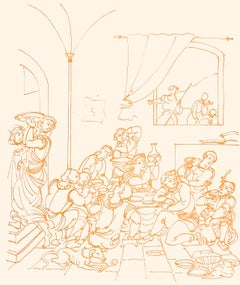André Derain Art
André Derain is best known as a leading figure of the avant-garde movement and — alongside Henri Matisse — a cofounder of Fauvism at the turn of the 20th century. Derain’s innovative use of expressive colors and simplified forms in his figurative paintings, landscapes and portraits continue to dazzle collectors and art enthusiasts everywhere.
Born in 1880 in Chatou, France, Derain began his formal art training at age 18 at the Académie Camillo, where he met Matisse and Maurice de Vlaminck. In 1905, Derain, Matisse and de Vlaminck exhibited their works at the Salon d’Automne in Paris, where critic Louis Vauxcelles used the word fauves (wild beasts) to describe the loosely connected collective of artists’ prioritization of audacious, vivid color in their energetic works, eventually leading to wide adoption of the term Fauvism.
In 1905 and 1906, Derain traveled to London, where he produced a series of Fauvist “form through color” paintings. These included The London Bridge, Charing Cross Bridge and A Corner of Hyde Park. After seeing a retrospective of Paul Gauguin’s work, Derain painted The Dance, a nude that is demonstrative of Gauguin’s influence in its bold, flat colors and in Derain’s depiction of primitive dancing figures.
In 1910, Derain destroyed many of his unsold works and began painting landscapes in the Cubist style of Paul Cézanne. He befriended Pablo Picasso and grew interested in African tribal art. After World War I, he focused on figurative and nude drawings and, in the early 1920s, abandoned Fauvism and Cubism altogether in favor of classical art. In 1930, the artist publicly condemned modernism, leading to his ostracization by the avant-garde community.
Derain was later honored with a retrospective of his works at the Kunsthalle in Bern, Switzerland. Additionally, the Exposition des Artistes Independants invited Derain to exhibit in 1937.
Derain’s wide range of styles — from Fauvism and Cubism to classicism and Postimpressionism — influenced many artists throughout his lifetime. Today, Derain’s work is held in the permanent collections of the Museum of Modern Art in New York, the Tate gallery in London, the Musée d’Orsay in Paris and the State Hermitage Museum in St. Petersburg.
On 1stDibs, discover original André Derain prints, drawings and paintings.
1950s Modern André Derain Art
Drypoint, Etching
1940s Modern André Derain Art
Lithograph
1950s Modern André Derain Art
Drypoint, Etching
1950s Modern André Derain Art
Drypoint, Etching
1950s Modern André Derain Art
Drypoint, Etching
1950s Impressionist André Derain Art
Etching
1960s Modern André Derain Art
Lithograph, Offset
Early 20th Century Impressionist André Derain Art
Etching
Mid-20th Century Folk Art André Derain Art
Woodcut
1950s Modern André Derain Art
Lithograph
1950s Modern André Derain Art
Drypoint, Etching
1950s Modern André Derain Art
Drypoint, Etching
1950s Modern André Derain Art
Lithograph
1950s Modern André Derain Art
Lithograph
1950s Modern André Derain Art
Lithograph
1950s Modern André Derain Art
Lithograph
1950s Modern André Derain Art
Lithograph
1950s Modern André Derain Art
Drypoint, Etching
1950s Modern André Derain Art
Drypoint, Etching
1950s Modern André Derain Art
Drypoint, Etching
1950s Modern André Derain Art
Drypoint, Etching
1950s Modern André Derain Art
Drypoint, Etching
1950s Modern André Derain Art
Paper, Etching
1930s Modern André Derain Art
Etching
20th Century Fauvist André Derain Art
Paper, Crayon
Early 20th Century Fauvist André Derain Art
Paper, Pencil
1910s Modern André Derain Art
Paper, Woodcut
1980s Contemporary André Derain Art
Lithograph
1950s Modern André Derain Art
Lithograph
1930s Impressionist André Derain Art
Etching
Early 20th Century Fauvist André Derain Art
Paper, Pencil
20th Century André Derain Art
Etching
1950s Modern André Derain Art
Lithograph
20th Century André Derain Art
Etching
20th Century André Derain Art
Etching
1910s Fauvist André Derain Art
Drypoint, Etching
20th Century André Derain Art
Etching
20th Century André Derain Art
Etching
20th Century André Derain Art
Etching
20th Century André Derain Art
Etching
1930s Modern André Derain Art
Etching
1970s Impressionist André Derain Art
Lithograph
1950s Modern André Derain Art
Drypoint, Etching
1950s Modern André Derain Art
Lithograph
1950s Modern André Derain Art
Lithograph
1950s Modern André Derain Art
Lithograph
1950s Modern André Derain Art
Lithograph
1950s Modern André Derain Art
Lithograph
1950s Modern André Derain Art
Lithograph
1950s Modern André Derain Art
Drypoint, Etching
1950s Modern André Derain Art
Drypoint, Etching
1950s Modern André Derain Art
Drypoint, Etching
1950s Modern André Derain Art
Drypoint, Etching
1950s Modern André Derain Art
Drypoint, Etching
1950s Modern André Derain Art
Drypoint, Etching
1950s Modern André Derain Art
Drypoint, Etching
1950s Modern André Derain Art
Drypoint, Etching
1950s Modern André Derain Art
Drypoint, Etching
1950s Modern André Derain Art
Drypoint, Etching
1950s Modern André Derain Art
Drypoint, Etching
André Derain art for sale on 1stDibs.
Artists Similar to André Derain
- 1stDibs ExpertApril 5, 2022André Derain was a painter and sculptor whose work is characterized by intense colors and simple, decorative forms. His approach to form and color created a framework that eventually led to the Fauvism movement. Shop a selection of André Derain’s pieces from some of the world’s top art dealers on 1stDibs.
- What is André Derain best known for?2 Answers1stDibs ExpertApril 5, 2022André Derain was a French painter and sculptor best known for co-founding the fauvism movement with Henri Matisse. He was one of the key figures in modern French painting. Shop a selection of André Derain pieces from some of the world’s top art dealers on 1stDibs.1stDibs ExpertApril 5, 2022French artist Andre Derain is best known for his work in sculpture and painting, particularly the Fauvist movement he helped co-found with Henri Matisse. Fauvism, French for “wild beasts,” uses strident colors and seemingly wild brush strokes. Shop a collection of authentic Andre Derain pieces from some of the world’s top sellers on 1stDibs.
